There’s a lot more to the northernmost part of our globe than just frigid landscapes. Read on for some fascinating facts about the Arctic region and the people and wildlife who call it home.
1. Bird poop helps keep the Arctic cool.
A 2016 study published in Nature Communications found that the massive amounts of bird guano in the Arctic release gases that contribute to cloud cover, which in turn slightly reduces the temperature of the surrounding air.
2. The Arctic is still lively during winter.
In some Arctic Ocean habitats, wildlife is even more active during the region’s long, dark winter than it is in the summer. According to a 2015 study in Current Biology, “Biodiversity, abundance, growth, and reproduction in habitats studied were at similar or higher levels than in warmer months.” Researchers counted lots of plankton, crustaceans, certain cod and haddock species, and a surprising number of birds going about their business in winter.
3. It’s home to the world’s biggest, most secure seed storage facility.
More than 800 miles beyond the Arctic Circle lies the Svalbard Global Seed Vault, a storage facility run by the Norwegian government. The structure, which was built into the permafrost, holds seeds for more than 4000 plant species—including life-sustaining food crops—keeping them safe in the event of natural or human-made disasters.
4. The first man to reach the North Pole was overlooked for decades.
American explorer Robert E. Peary claimed to have been the first man to reach the geographic North Pole, in April 1909. Today, however, experts argue that it was his assistant, Matthew A. Henson, who actually deserves the distinction. By the time Peary and Henson and four Inughuit dog sled drivers neared their destination, Peary was struggling with a bad case of frostbite, leaving him unable to walk. (He had to be pulled along on a sled instead.) As they got closer to the North Pole, Henson and two guides went ahead on foot, but accidentally overshot their destination—which meant that Henson technically reached the Pole about 45 minutes before Peary did.
5. Millions of people live in the Arctic.
Despite its harsh conditions, about 4 million people call the Arctic home. Parts of the U.S., Canada, Greenland (which is a territory of Denmark), Iceland (barely), Norway, Sweden, Finland, and Russia are above the Arctic Circle. The largest Arctic settlements are Murmansk (population: about 270,000) and Norilsk (184,000) in Russia and Tromsø (78,000) in Norway, with smaller cities in the other circumpolar countries. Inuit, of many groups and communities, make up a large majority of Arctic residents in North America and Greenland.
6. There’s an intergovernmental forum just for the Arctic.
Countries whose borders fall north of the Arctic Circle are part of the Arctic Council, which, according to its website, “is the only circumpolar forum for political discussions on Arctic issues, involving all the Arctic states, and with the active participation of its Indigenous Peoples.” The council works to assess and solve environmental, economic, social, and cultural issues across the region.
7. The word Arctic is derived from Greek.
The Greek word arktos means “bear,” and refers not to the region’s native polar bears, but to the circumpolar constellation Ursa Major. (Ursa is Latin for “bear.”)
8. The Arctic Ocean is the world’s smallest.
It comprises 5.4 million square miles. By comparison, the Atlantic Ocean covers 41.1 million square miles, and the Pacific 62.46 million square miles.
9. The North Pole is much warmer than the South Pole.
The Arctic is mostly ocean surrounded by land, while Antarctica is land surrounded by ocean. While significant portions of both are covered in sheets of ice, the Arctic Ocean holds more heat that helps warm (relatively speaking) the surrounding air. The landmass of Antarctica, in contrast, is covered with an ice sheet more than a mile thick in places and over 9000 feet in elevation at the South Pole. Higher elevations, of course, result in colder temps. The average summer temperature at the North Pole is 32°F. At the South Pole, it’s -18°F.
10. Santa’s North Pole home was dreamed up by a 19th-century cartoonist.
The famous political cartoonist Thomas Nast began drawing illustrations of Santa Claus as part of an advertising campaign for Harper’s Weekly in the 1860s. In a few of his drawings, he made reference to the fact that Santa’s mailing address was the North Pole—a place that had already captured the world’s imagination, as they watched a number of explorers attempt to reach the frigid destination. As for the real St. Nicholas? He was born in what is now Turkey.
A version of this story was published in 2016; it has been updated for 2023.
This article was originally published on www.mentalfloss.com as 10 Fascinating Facts About the Arctic.

